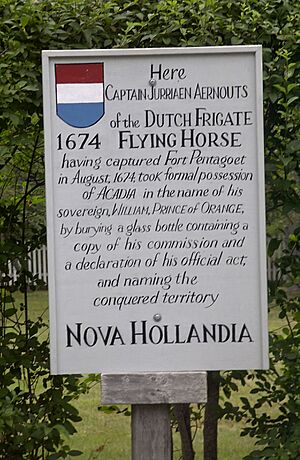New Holland (Acadia) facts for kids
New Holland (also called Nova Hollandia) was a colony started by Dutch naval captain Jurriaen Aernoutsz. He created it after taking over Fort Pentagouet in Penobscot Bay (which is now Castine, Maine). This fort was the main city of Acadia. Captain Aernoutsz also captured other villages in Acadia during the Franco-Dutch War.
The Dutch captured the Governor of Acadia, Jacques de Chambly. However, French forces and their Native American allies, led by St. Castin, took back control of the area in 1675. Even so, a year later, the Dutch West India Company named Cornelis Steenwijck as the new governor of "Nova Scotia and Acadie." The Dutch officially gave up their claim to Acadia in 1678 when the Treaty of Nijmegen was signed.
Contents
How Did New Holland Begin?
The Franco-Dutch War and a New Plan
The Franco-Dutch War started in 1672. At first, England was on France's side. But by early 1674, England and the Netherlands had stopped fighting each other.
A few months later, in July 1674, Captain Jurriaen Aernoutsz sailed into New York harbor. Before this, he had been sailing the North Atlantic Ocean. His mission was to find and attack English and French ships.
A Helpful Guide and a Bold Idea
In New York, Captain Aernoutsz met a trader named John Rhoades. Rhoades was from Massachusetts and knew a lot about the fur trade in Maine and Acadia. He told Aernoutsz that the Dutch were no longer fighting the English. However, France was still at war with the Netherlands.
Rhoades also explained that the French colony in Acadia was not well protected. He suggested it would be easy to conquer. Aernoutsz liked this idea, and his crew agreed right away. John Rhoades became their guide.
Taking Over Acadia's Capital
Captain Aernoutsz quickly sailed with 110 soldiers towards Fort Pentagouet. This fort was the capital of Acadia, located in Penobscot Bay (modern-day Castine, Maine). On August 10, 1674, they attacked the fort.
There were only 30 French soldiers inside, and they did not have many weapons. The Dutch soldiers took the fort easily. They also captured the French military headquarters there. After this victory, they sailed to Jemseg and captured another French fort.
At both Fort Pentagouet and Jemseg, Aernoutsz buried bottles. Inside these bottles were messages saying that "Acadie" was now Dutch land. From then on, it would be known as Nova Hollandia, or "New Holland." The Dutch also took the Governor of Acadia, Jacques de Chambly, as a prisoner.
What Happened Next?
After his victories, Aernoutsz sailed to Boston. There, he sold the things he had taken, even the cannons from Fort Pentagouet. He sold them to the government of Massachusetts.
Around October 1674, Aernoutsz sailed to Curaçao. But he left his prisoners and some of his crew in Boston. John Rhoades was among those left behind.
However, Massachusetts soon stopped Aernoutsz's plans. John Rhoades and the other men in Boston were following Aernoutsz's orders to go back to Acadia and keep control. They started taking New England ships that were trading with Native Americans. Massachusetts arrested Rhoades and his group. They were put on trial for being pirates. In the end, they were either set free or told to leave Massachusetts.
The End of New Holland
A New Governor and a Short Claim
In September 1676, the Dutch West India Company tried to make use of Aernoutsz’s earlier success. They gave Rhoades permission to live and trade in Acadia. They also named Cornelis van Steenwijck, a Dutch merchant from New York, as the governor of "Nova Scotia and Acadie."
Even though the Dutch claimed this land, they did not have strong control over it for long. Later in 1676, the French took back control of the two forts. On May 20, 1676, Governor Jacques de Chambly was put back in charge of Acadia.
The Treaty That Ended It All
The disagreement over the colony was finally settled by the Treaty of Nijmegen in 1678. In this treaty, the Dutch officially gave up their claim to the colony. The treaty did not specifically mention New Holland, but it also brought an end to the larger Franco-Dutch War.


